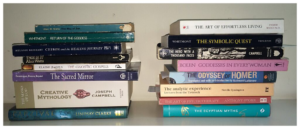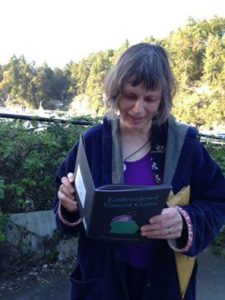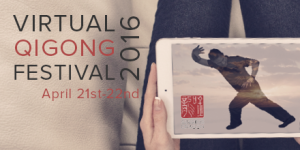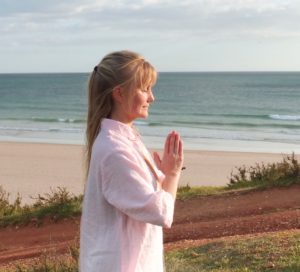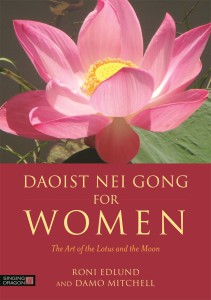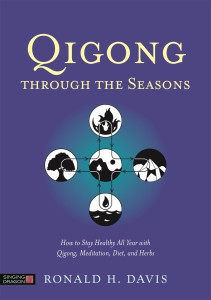#QigongFestival2016
by Camilo Sanchez, L. Ac, MOM
Traditionally, the practice of qigong comprises different phases of training based on the various stages of cultivating vital energy or qi. Schools of qigong variously mention four, five, six and even seven phases of practice. However, despite these differences, the general procedure of qigong practice remains all the same.
In the school of Taoist qigong we follow six main stages of practice. This article describes the main phases of training and the requirements for each stage of practice.
-
Unblocking Qi and Strengthening Postnatal Qi (nei yang gong)
During the first phase of qigong training the focus is on unblocking qi and conditioning the physical body by opening the joints, lengthening the tendons and connective tissues, increasing flexibility of the spine, and releasing restrictions to the flow of vital energy in order to strengthen and improve the circulation of the guardian qi (wei qi) on the surface of the body. At this stage of practice we pay attention to cultivating relaxation (song), achieving correct body posture and fulfilling the five essential requirements for aligning the body, learning the principles of proper body mechanics, improving breathing, and establishing the three external harmonies (wai san he), namely harmonizing the shoulders with the hips, the elbows with the knees, and the hands with the feet.
This phase of training involves clearing blockages of qi from the energy channels, regulating the body, and optimizing the absorption of postnatal qi derived from nutrients and breathing. It may include the practice of dynamic qigong (dong gong), breathing techniques (tu na), gymnastics (dao yin), internal martial arts, and the use of diet and medicinal herbs to strengthen the body, restore health and increase vitality. At the same time, we begin the practice of qigong stances (jing gong) and meditation so as to calm the mind, relax the nervous system and cultivate tranquility.
-
Harnessing and Generating Qi (yang qi)
In the second stage of practice we aim at gaining control of the three energies acquired after birth (hou tian qi) including the qi derived from food and breathing (acquired qi), the reproductive essence (acquired jing), and our conscious mind (acquired shen), to help replenish the procreative essence of the body (yuan jing) as the foundation for the following phases of qigong practice. Our original essence (yuan jing) has been likened to the oil that feeds the wick of a lamp. It serves as the basic energy or fuel required for the processes of internal energy transformation. Without it the wick will burn quickly and the lamp will die out. Traditionally, this stage has been called “Laying the foundation” (zhu ji).
We focus on training the breath until it is long, deep, slow, even, smooth and fine, as well as coordinating the breathing with the stances and the external movements of the body. At this stage of practice the three external harmonies should be coordinated with the three internal harmonies (nei san he) of vital energy (qi), intention (yi), and heart-spirit (xin) where the qi leads the movements of the body, the intention leads the qi, and the spirit leads the intention.
At this stage the practitioner makes use of mind focus to guide breathing to the abdominal region thus bringing more blood and nutrients into the lower dan tian and the life gate region (ming men). This process helps to strengthen the procreative essence of the body and hormonal production (jing), in this way establishing a good root or foundation (zhu ji).
Harnessing qi requires improving the absorption of qi from nutrients and breathing, opening the qi field of the body to harness qi from nature, reducing the dissipation of vital energy through the cultivation of stillness and tranquility of the mind, and preserving our sexual energy or jing. The three dan tian centers are specific locations for gathering, generating and cultivating the three internal energies of procreative essence, vital energy, and spirit.
-
Refining Essence to Vital Energy (lian jing hua qi)
After the procreative essence of the body has been restored and made complete again, it needs to be refined into original qi (yuan qi). This process of transformation is accomplished through circulating vital energy along the controlling vessel (du mai) and the function vessel (ren mai). The constant cycling of vital energy along the small heaven orbit refines essence into original qi, the same way that exciting the movement of water through the application of fire transforms liquid into steam and gas.
At this level of practice one achieves the coordination between the external movement of the body and the internal movement of qi. When practicing the various exercises the intention, the qi and the movements of the body are integrated into a unified action. At this point in the training one achieves proficiency in the practice of moving qigong (dong gong), experiences a strong current of qi, and is able to control the movement of qi inside the body.
This phase of training requires that one cultivates a clear, tranquil and natural state of mind so that the mind links with the qi and guides the flow of vital energy inside the body. This stage of qigong involves activating the small heaven orbit of qi (xiao zhou tian), circulating internal qi, and refining essence to vital energy.
-
Emergence of the Inner Elixir (jie dan)
This is the stage in which the qi acquired after birth joins and combines with the prenatal qi. The process of inner contemplation and stability of the spirit refines original qi in a higher level energy or shen with its own special functions. At this stage the practitioner aims at taming the mind and minimizing desires. One reaches a state of stillness and clarity of the spirit thus recovering the original nature of the mind.
Refining vital energy to spiritual energy is marked by the activation of the large heaven orbit (da zhou tian), also known as “The intercourse between heaven (qian) and earth (kun)”. It comprises the circulation of refined qi through the central channels in the arms, legs and trunk (zhong mai). Furthermore, opening the grand heaven orbit has the broader meaning of opening the channels and qi field of the body to the field of nature and freely interchanging energy with the primordial qi of the cosmos. At this stage of qigong cultivation all the energy channels are open and clear and vital energy flows smoothly throughout. The maturation of the large heaven orbit marks the state of fetal breathing (tai xi). This is the phase of refining vital energy (qi) to spirit (shen).
Traditionally, it is said that this phase of practice takes about ten months to complete so it is referred to as the “Ten month pass” (shi yue guan). However, this time frame should not be taken literally as the time required to go through these transformations cannot be fixed and will vary according to the individual and other factors surrounding one’s practice.
At the completion state of this phase the practitioner realizes internal light and perceives the internal organs. Also, various potential extra-sensorial abilities may become manifest according to the methods of practice and nature of the individual. At the advanced state of fetal breathing, external breathing stops through the nose, and one enters a state of profound serenity where internal breathing through the dan tian and the pores of the skin becomes activated.
-
Transition to External Elixir (wai dan)
The complete refinement of vital energy to spirit will lead to the return of spirit back to emptiness, or a virtual state. This stage marks a transition from the previous phases characterized by conscious effort (you wei) to a condition of non-interfering or non-doing (wu wei), which is a state of non-localized awareness and mindful emptiness.
When qigong practice reaches this stage, the flow of internal energy is not limited to specific channels and vital points, but it will be able to flow like running water filling the entire space of the arms, legs, and trunk, and reaching the center of the palms, bottom of the feet and crown of the head.
The practitioner is able to guide internal energy and establish a permanent line of qi between the two lao gong cavities on the palms. Over time, the sensation of external qi expands, increases, and becomes stronger. With further practice, the flow of qi to the hands and the exterior of the body will combine with the ball of qi inside the dan tian center thus uniting the internal qi with the external qi. At this stage of qigong the practitioner is able to direct and issue internal energy to the qi cavities at will for healing with qi, or self-defense usage. This stage of cultivation includes activating the large heaven orbit of qi (da zhou tian), refining vital energy (qi) to spiritual energy (shen), and issuing external qi.
This phase marks the completion of the immortal spirit or yang spirit (yang shen), which later will be released through the central channel of the body, also known as the fetal channel (chong ju), and out of the body from the opening at the crown of the head. The complete refinement of vital energy to spirit culminates in the formation of the great elixir (da dan). The great elixir manifests as a bundle of energy that settles in the lower dan tian and serves as the seed of the original spirit (yuan shen).
Traditionally, this stage is described by the terms “Nine years pass (jiunian guan)”, or “Nine years facing the wall” referring to the story of Bodhidharma, the first Zen (Chan) Buddhist Patriarch of China, who at this stage of cultivation sat facing the wall for nine years. In Taoist internal alchemy the number nine symbolizes a high level of completion. Thus, this state of practice indicates an advanced level of inner refinement and a return to the original state of body and spirit.
Consciousness is brought back to its pristine purity and clarity and the mind dwells on xing, or one’s original nature. The spirit abides in absolute emptiness and void. In this context emptiness doesn’t mean a state of complete void or nothingness. Rather, it is an experiential dimension devoid of any subjective impressions and dualistic concepts, also known as a virtual state because it contains the potentiality for manifesting any phenomena and it provides a gateway to transcendental reality.
-
Returning to Original Nature (yuan xing)
When the practitioner reaches this stage the “Heavenly eye” will open-up and various potential abilities of the human body will become manifest. With the opening of internal vision the practitioner will develop the special functions of qigong cultivation. The development of these potential faculties will vary in each individual depending on the nature of the practitioner, state of health, method of training, previous karma and level of cultivation, among other factors surrounding one’s practice.
Breaking from all attachments, including the attachment to emptiness itself, and shedding any subjective feeling or trace of individuality will allow consciousness to attain a state of oneness. At this point, the individual realizes complete enlightenment (yuan jue) and merges with the great Tao.
This stage highlights uniting the three original energies of jing, qi, and shen into the yang spirit (yang shen) in the head, releasing the spiritual body (yang spirit) to merge or unite with the Tao, enlightening the mind, and realizing one’s nature. This is the stage of returning shen (consciousness) to original nature or Tao, and connecting with the primary qi of the universe (xian tian zhen yi zhi qi). In this way, one can establish the root of the golden elixir (jin dan). It is from this foundation that we can cultivate Tao and approach our true nature.
The higher levels of qigong involve the cultivation of xiu lian or purification and refinement. Since there is a direct relation between the state of vital energy and the state of the mind, one can only reach up to a certain level of achievement in qigong practice without purification of the mind. Xiu lian is the practice of transforming the quality of the mind, adjusting behavior, balancing lifestyle, and cultivating one’s spiritual nature. In short, it involves the cultivation of virtue (te), character and merit (gong). Without the cultivation of character one cannot harmonize the mind and without harmonizing the mind it is not possible to cultivate our vital energy or qi.
Camilo Sanchez is the author of Daoist Meridian Yoga. For more information, click below.
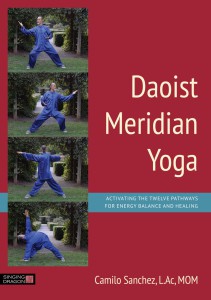
 As both Emma and Jane have mentioned in previous posts, our work patterns at Singing Dragon/JKP can rarely be neatly packaged into what you might call a normal routine, and over the past few months I would say that routine has featured less for myself than any other member of staff. I have worked as a general intern here since the end of December, and because this entails assisting the full range of departments, I very rarely find myself doing the same work from one day to the next.
As both Emma and Jane have mentioned in previous posts, our work patterns at Singing Dragon/JKP can rarely be neatly packaged into what you might call a normal routine, and over the past few months I would say that routine has featured less for myself than any other member of staff. I have worked as a general intern here since the end of December, and because this entails assisting the full range of departments, I very rarely find myself doing the same work from one day to the next.